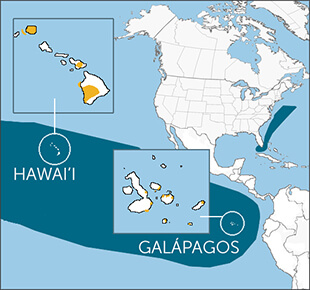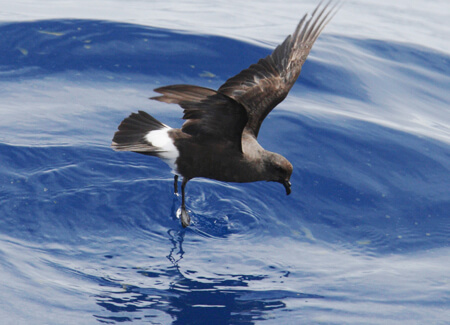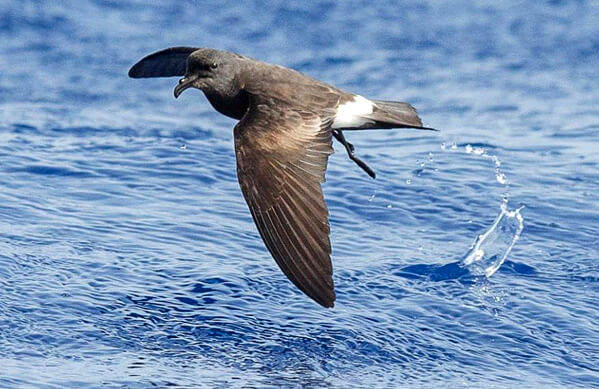
Band-rumped Storm-Petrel range in the Americas. Map courtesy Birds of North America, https://birdsna.org maintained by the Cornell Lab of Ornithology
The dainty Band-rumped Storm-Petrel, known as the ‘Ake‘ake in Hawai'i, is named for the white band across the top of its broad, squared-tipped tail. Its genus name, Oceanodroma, derives from the ancient Greek words for "ocean" and "runner," probably derived from the bird's habit of paddling with its feet while it flies low over the water.
Robin-sized Wanderer
A full-grown Band-rumped Storm-Petrel weighs only about one-and-a-half ounces — about the same as a golf ball. It's similar in size to an American Robin.
Like many pelagic species, Band-rumped Storm-Petrels wander widely. From ocean-going boats off the Carolinas and Gulf of Mexico, birders call out these birds' short wing strokes and rigid glides, contrasting this flight pattern with the Leach's Storm-Petrel's bouncy, erratic flight and the Wilson's Storm-Petrel's fluttery strokes. These two species exhibit slightly different field marks from the Band-rumped, including the Leach's sharply notched tail and the Wilson's long legs, which leave the feet protruding beyond the tail.
This ash-black seabird belongs to a large group of pelagic seabirds, including Markham's Storm-Petrel, Ringed Storm-Petrel, and Galápagos Petrel, that are poorly known and increasingly threatened by human activities. Band-rumped Storm-Petrels face the same threats as other island-nesting seabirds such as Waved Albatross and White-tailed Tropicbird: habitat loss and introduced predators, especially rats, cats, and mongooses.
In Hawai'i, where many non-native birds have taken up residence, introduced Barn Owl populations are also a problem. Collisions resulting from light attraction also threaten this species, as well as other endangered seabirds like Newell's Shearwater and Hawaiian Petrel.
Bird of Geographic Distinction
The Band-rumped Storm-Petrel ranges across tropical and subtropical regions in the Atlantic and Pacific Oceans. Some scientists suspect there may be as many as 10 geographically distinct populations of Band-rumped Storm-Petrel, breeding in far-flung locations including Japan, the Galápagos Islands, and islands in the Atlantic, as well as in Hawai'i.
Based on vocalizations and nesting seasons, four genetically distinct populations (perhaps even species) may breed in the North Atlantic alone. One population from the Azores archipelago in the mid-Atlantic was identified as a distinct species — the Monteiro's Storm-Petrel — in 2007, based on vocalizations, genetic analysis, and timing of its nesting season.
The population of Band-rumped Storm-Petrels on the Hawaiian Islands may also represent a distinct species, but more information is needed. A 2017 study used acoustic song meters and other surveying methods to add to existing knowledge on the distribution and relative abundance of this storm-petrel on Kaua‘i and Lehua, but much about its life cycle remains to be discovered.

Band-rumped Storm-Petrel. Photo by Mike Danzenbaker
Inaccessible Nesters
Scientists have found few Band-rumped Storm-Petrel nests in Hawai'i because the species prefers to nest in crevices high on cliff faces or lava flows — places that are extremely difficult for people to access. Like many other seabirds, they fly to their breeding sites under the cover of darkness to avoid attracting predators.
The steep cliffs of Kaua‘i have seen the most documented breeding activity of the species in the Hawaiian archipelago. Band-rumped Storm-Petrels have also been recorded at night on Maui and the Big Island, so they are likely breeding in small numbers on those islands as well.
Casting about for Dinner
When it comes time to feed, Band-rumped Storm-Petrels range widely over deep, warm waters, mostly eating small fish, squid, and crustaceans found in plankton. But the birds also ingest human refuse and sometimes nutrient-rich whale feces. They mainly feed by day on the wing, pattering or dangling their feet in the water and grabbing food off the surface.
Band-rumped Storm-Petrels frequently follow whales and dolphins, as well as tuna and other large predatory fish, to feed on food scraps left behind. (Watch an ABC video on seabird foraging techniques.)
Sign up for ABC's eNews to learn how you can help protect birds
Reducing the Threat of Predation
The Band-rumped Storm-Petrel is listed as Endangered, both federally and in the only U.S. state where it nests, Hawai'i. All of its other populations bear watching, as they face, to varying degrees, similar threats of habitat loss and introduced predators.
ABC and partners are working to protect Band-rumped Storm-Petrels and other endangered Hawaiian seabirds by reducing the threat of predation in their mountain colonies on Kaua'i. Our Seabirds program is involved in predator-proof fencing projects on several Hawaiian islands, including Kaua'i, which effectively address this threat.
Donate to support ABC's conservation mission!



















































